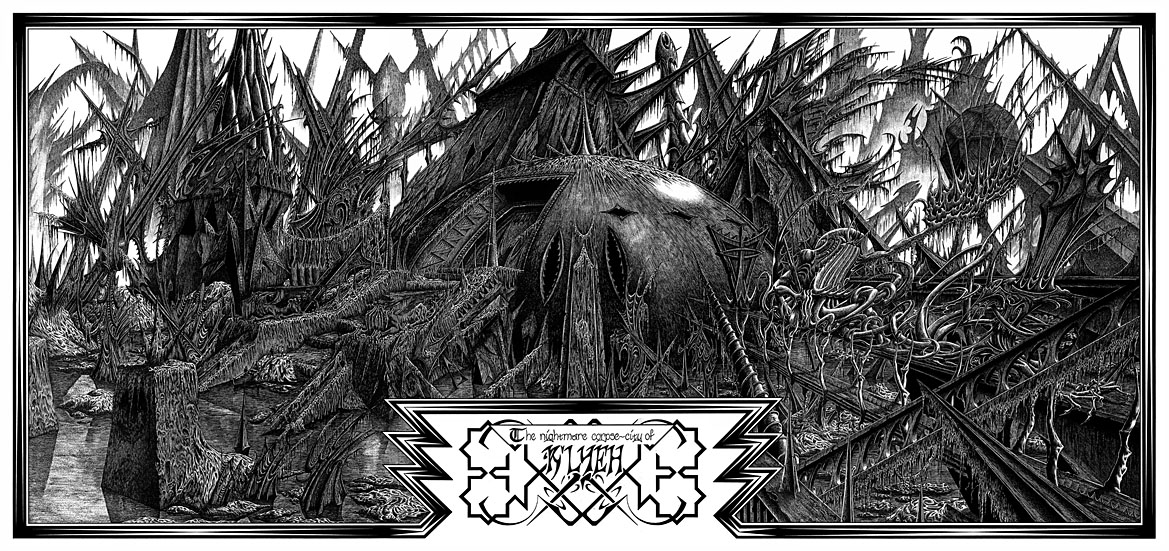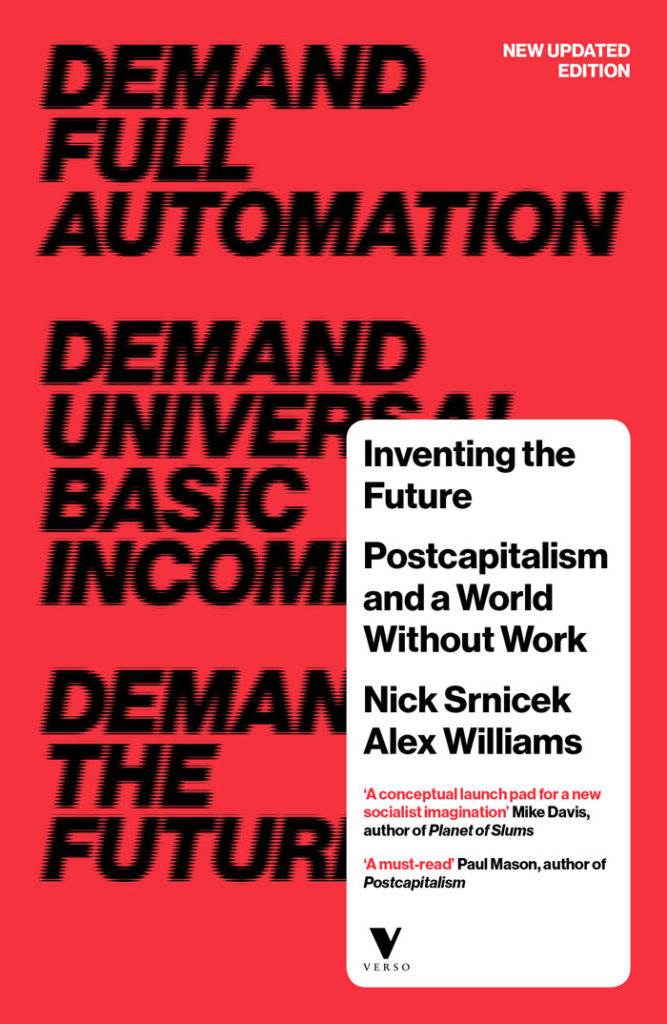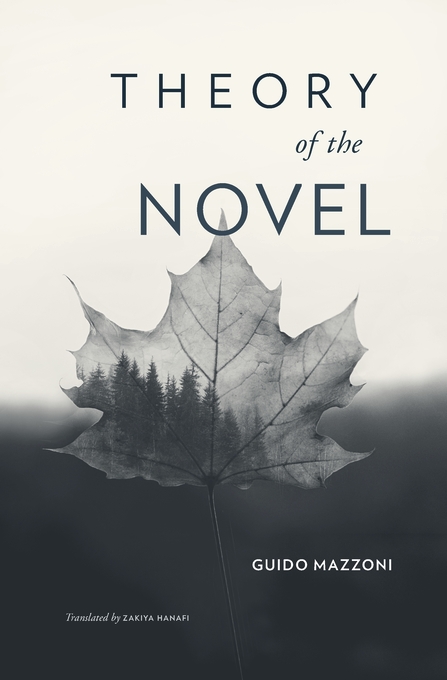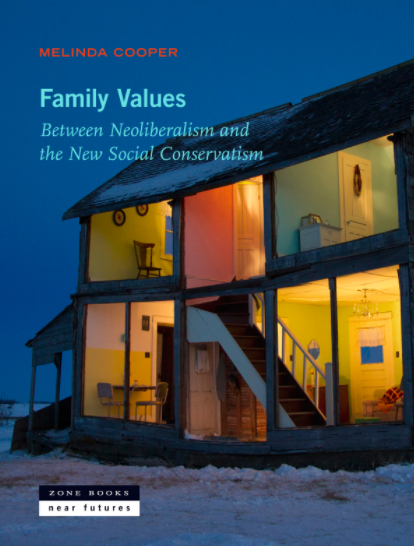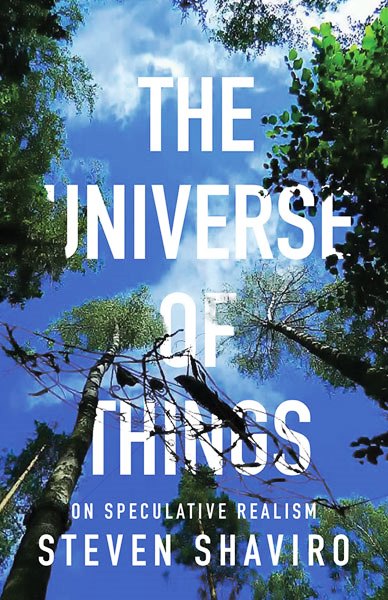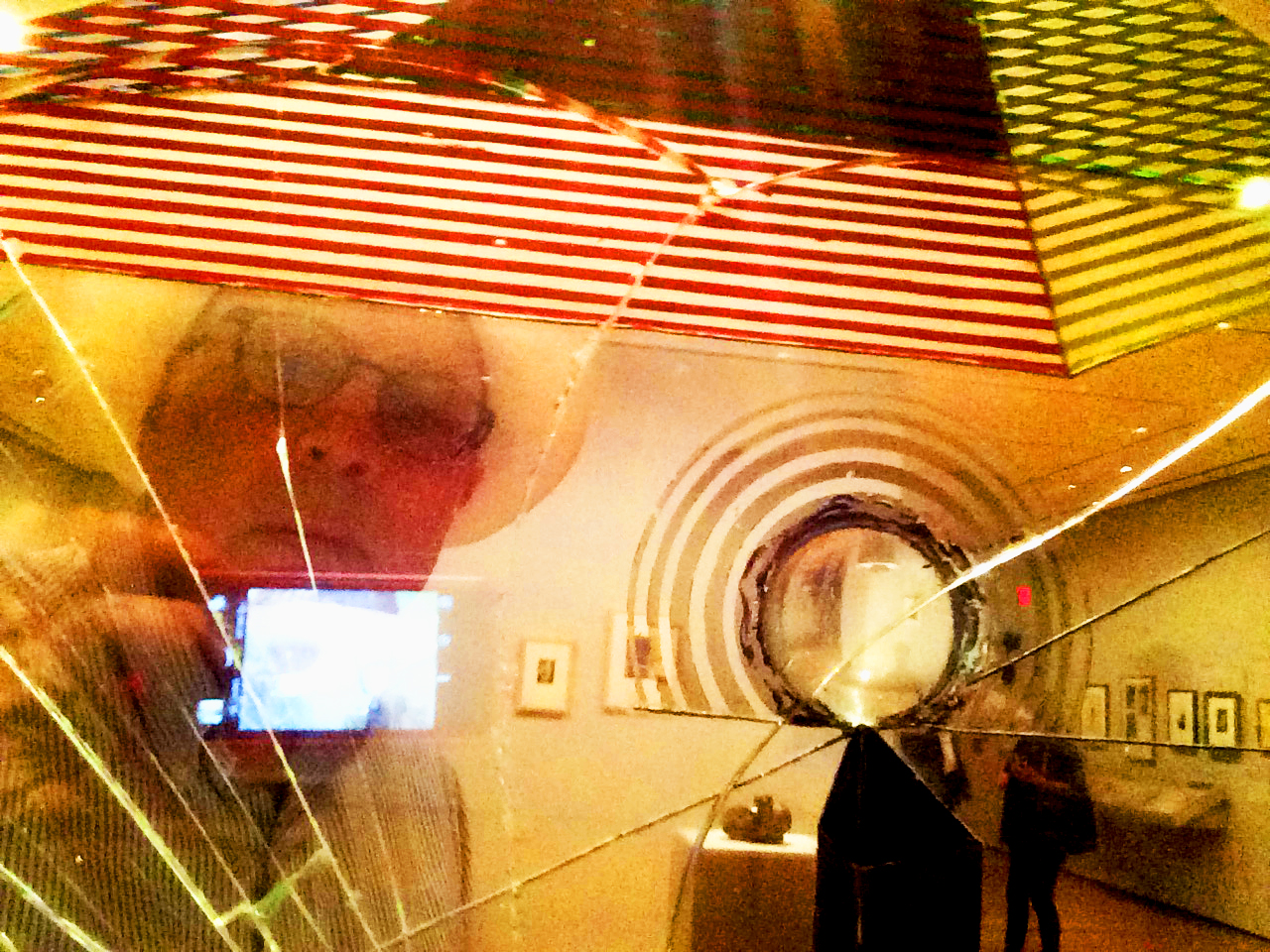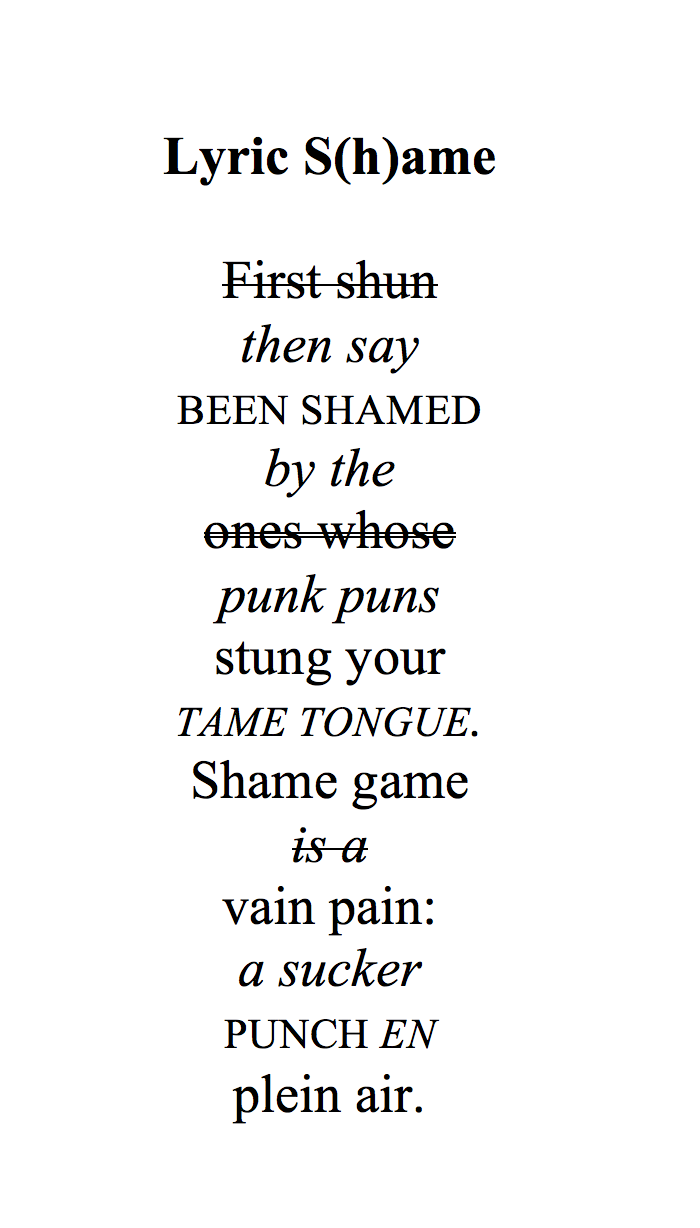by Alexander R. Galloway
This interview has been peer-reviewed by the boundary 2 online editorial collective.
Alexander R. Galloway: Critical theory tends to subdue biography, but I’d like you to reflect on your own trajectory as a thinker. Your last few books all fit together. How do you conceive of the project that began with The Beach Beneath the Street (2011), and continues through The Spectacle of Disintegration (2013), up to Molecular Red (2015)? It’s a story about the Situationist International, to be sure, but your story is both broader and longer than the specific locus of the S.I. Did you set out to rewrite the history of radical modernity? What stories do you want to tell next?
McKenzie Wark: I would include A Hacker Manifesto (2004) and Gamer Theory (2007) in that trajectory. Those books are already about the mode of production after capitalism that runs on information. The former was a more optimistic book about the new kinds of class conflict that could shape it; the latter a more pessimistic one about its new modes of incorporation and control. But I felt that nobody was quite getting the alternate path through the archive those books implied. So I decided to write some more pedagogic books that laid out the resources one could use to “leave the twenty-first century.”
That led to the three books you mentioned plus another to come that are indeed a cycle about rewriting radical modernity. Not that this is the only alternate path through the archive, but it’s an attempt to suggest a different relation to the archive in general, to see it as a labyrinth rather than an apostolic succession; a kind of “no-dads” theory, but full of queer uncles and batty aunts.
Molecular Red has a bit about the moment of the October Revolution, rethought through Bogdanov and Platonov. Then, second in the sequence, would come the one I haven’t finished, about the British scientific left, the original accelerationists and cyberfeminists. That covers the 1930s – ’50s. Then The Beach Beneath the Street, which reads the situationists as radical theory, not art, and expands the story beyond Guy Debord. The Spectacle of Disintegration continues that dérive through the archive by way of the post-’68 moment. What to do when the revolution fails? As a book-end, there is the last part of Molecular Red about Donna Haraway, but read as a marxist as well as feminist thinker, a reading I then take through a cluster of people with Haraway-affinities.
My job at The New School is really not ideal as far as doing research is concerned. So these are more writerly than scholarly books. They are meant to legitimate spaces in which others might do more thorough work. I want to leave nice, big attractive spaces for grad students or artists or activists to go set up camp. And people do, which makes me happy. In my small way I think I enabled some of the new work on Bogdanov, the Situationists, Haraway in relation to Marx, and so on.
I find it enervating when people simply try to squeeze the present into the old patterns set by Walter Benjamin or whomever, and add just a tiny bit of novelty to how we read such a canonic figure. Why not read other people, or read the present more in its own terms? Ironically, to best honor Marx or Benjamin one should not simply be their exegetes. So my job is to corrupt other people’s grad students. To be the odd uncle (or auntie) who whispers that one can dissent from the great academic patriarchy (and even its subsidiary matriarchy) where one only succeeds through obedience to the elders and the reproduction of their thought.
AG: Can you also reflect on your move to the United States, where you’ve lived now for over fifteen years? I know you’ve commented on how disconnected American academia is from other parts of the world, particularly Australia–an observation that could be spun negatively or positively. (American schools are tuition-driven and hyper capitalist, yet ironically still largely free of neoliberal bureaucratization along the lines of Britain’s onerous Research Excellence Framework.) And you’ve also mentioned in the past how you received a rather unique political education in Australia. Can you say more about your life during the Twentieth Century?
MW: I had a great education of the provincial petit-bourgeois kind. I learned at the feet of labor movement militants and later from various self-invented avant-gardes and proto-queer bohemias. Things were already going badly in Australia in the nineties so I wrote what I think of as my “popular front” books. The Virtual Republic (1997) was about the culture wars, in the spirit of Lyotard’s differend. I wrote another one about two versions of the popular: social democratic and hyperreal. But then I fell in love with a New Yorker, so I gave up tenure, moved to New York, and started over. Probably a lucky escape, as so far the diversity of economic models has kept American universities in better shape than in state systems such as the UK or Australia.
In Australia I was part of what Mark Gibson called the “republican school” of cultural studies. Republican in the sense of the res publica, the public thing, or more figuratively of cutting to the heart of a problem and exposing it. We weren’t interested in cultural policy or simply doing critique from the sidelines, but of trying to effect the national-popular space of cultural conflict itself. But I was already a bit critical of the superstructural turn cultural studies represented, its bracketing off of questions of media form, and with them of the mode of production and historical stage. In Virtual Geography (1994) I had already wanted more a theory of the media vector as shaping a certain kind of space of action.
It just seemed untenable to do anything like the same sort of work in America, where I had no access to the public sphere. I was nobody. And I already wanted to move away from the post-Marxism of say Hall and Laclau and Mouffe, that turn to either the cultural or political as autonomous or even ontological. That did not make a lot of sense if you looked around at the big world a bit. So I went back to my earlier formation in classical and western Marxism as well as in the avant-gardes, and wrote A Hacker Manifesto. That was my first “American” book, even though it came out of participating in the transnational digital avant-gardes of the nineties, something of interest to me alongside the “popular front” work I was doing at that time.
AG: Is it fair to say that you have a reticence toward high theory and big thinkers, figures like Alain Badiou with his intricate if not onerous systems? You are not a system builder, if I may speak plainly. Instead you are proud to pursue a kind of “low theory.” Provisionality, tactical intervention, tinkering and recombination, intellectual creativity, but also impurity–although I can never tell if you are a pragmatist or an idealist! Can you comment on the fascinating mixture that constitutes low theory?
MW: I was formed by the labor movement, and I remain in solidarity with it even though it is in a sense a god that died. So how does one keep living and working after defeat? There’s something to be said for knowing one is of a defeated people. One is free from the silly chatter of optimism. And one knows who one’s real comrades are. They are the ones you still have after the defeat. I still retain that side, which for me is a kind of decision that can’t be revoked, a picket line never to cross.
On the other hand, my other commitment is not to the community of labor but the community of non-labor, or bohemia. Its expression is not the organized labor movement but the disorganized avant-garde. It’s not uncommon to combine these things, of course. But most often they are combined in the form of (sometimes rather dreary) Marxist theories about the avant-garde, which nevertheless remain very conventional in form. It seemed to me self-evident that one should also reverse the procedure, and apply avant-garde techniques to the writing of theory itself. Hence A Hacker Manifesto uses Situationist détournement and Gamer Theory uses Oulipo-style constraints.
Low theory refers to the organic conceptual apparatus a milieu composes for itself, at least partly outside of formal academic situations. Both the labor movement and the avant-garde did that. I think it is useful to have that base, even if it is an attenuated and defeated one. It’s useful to have some perspective outside of the criteria of success of academia itself. After all, many of the “greats” of low theory–Spinoza, Marx, Darwin, Freud–they were not philosophers.
AG: So low theory means anti-philosophy? I’ve noticed that some commentators prefer to define anti-philosophy as a kind of anti-rationalism (that being Badiou’s gripe) or even some type of a mystical romanticism. But these definitions of anti-philosophy never made sense to me.
MW: Badiou thinks philosophy has a monopoly on a certain kind of reason, but more out of institutionalized habit than anything else. You could think of low theory as what organic intellectuals do. It’s defined by who does it and why, rather than by any particular cognitive style. I’m interested in how, after the organic intellectuals of labor, there are organic intellectuals of social movements, everyday life, the experience of women or the colonized, and of new kinds of activity that are not traditional labor in fields like media and computation. Concepts get formed differently and are meant to do different things when you are trying to think through your own action in the world rather that when you are a scholar of action in the world.
AG: I’m also intrigued by what you say about form, since this always struck me as the central question for Marxism, if not for all attempts to think and act politically. There’s the critique of the commodity of course, where form takes a beating. But at the same time form–particularly as idea or concept–seems absolutely crucial to me, not as the thing to be avoided, but as a scaffolding to propel people forward. Do you think idea, concept, or form has a place in Marxism?
MW: As extracts or abstracts from practice, concepts attempt to grasp a range of practical particulars within a conceptual form. The concept is only going to be slightly true, but about a lot of situations. As opposed to a fact, which is mostly true, but about a particular. Concepts are handles for grabbing a lot of facts. The thing to avoid however is the temptation to think the concept is more true than the practice. As if it were some underlying essence or ontology. I’d call that the “philosophical temptation.”
I think one has to wear one’s concepts lightly, and I think Marx did that, if not consistently. His concepts modify over time as he gets further along in thinking practice, and of course as the experience of living within capitalism changes. Capitalism isn’t an eternal essence with changing appearances. This is of course a mere thumbnail sketch of an epistemology, but then it ought not to be too big a distraction. Knowledge practices are experiments. There’s no royal road to science.
Form is however a rather larger question, particularly as forms, unlike concepts, are embodied and implanted in social life itself. The commodity form, for example. But they are still not essences. The commodity form mutates, and not least in contact with other forms: the property form; technical forms. I’m particularly interested in how the information form (a redundant phrase, I know!) and the commodity form mutually transform each other. It is not that information was subsumed within the commodity form, which remains the same essence. Rather each changes the other. Which is maybe why this is not our grandparents’ capitalism, if it is still capitalism at all. It may be a worse ensemble of forms, including what Randy Martin calls the derivative form.
AG: You always pull me back from the precipice of the concept! I value that about your work. Although I can’t help but question the notion of “no royal road,” and am reminded of larger discussions about the critique of method, or the notion that method can’t or shouldn’t exist. Wouldn’t you agree that the rejection of method is an ideology in itself, an ideology that, in fact, can be isolated very precisely around a certain Anglo-American configuration of empiricism, pragmatism, and realism?
MW: The shadow of not one, but two historical exclusions hangs over our received ideas about all this. Certainly there is a Cold War in western knowledge that has to do with suppressing anything that is not empiricism, pragmatism and realism. Recall how the CIA funded Michael Polanyi’s efforts to construct a philosophy of science that saw science as functioning best as a “free market of ideas”–and at the very time it was becoming the exact opposite, entangled as it was in the military industrial complex. This calls for some detours into the archive to see what was excluded.
The new left rescued various philosophical alternatives, most notably what came to be constructed as “western Marxism.” But it neglected certain other suppressed traditions, the scientific socialism of Waddington, Bernal, Needham and Haldane being just one of them. So I think there’s still a project there to reclaim some other missing resources.
But there was another exclusion, which happened earlier, and within Marxism itself. That was the suppression of the “Machists.” Both the Russian and German strands of Machism, despite a lot of political and theoretical differences, had one argument in common: that a merely philosophical materialism is no materialism at all. A merely philosophical materialism will simply reify and take as first principles some metaphors drawn from the science and industry of its time. Rather, materialism ought to open philosophy to the world, to other practices of knowledge and action, including those that generate low theory. Philosophy can’t be sovereign. It has to accept comradely relations with other practices, not one of command.
The decisions for or against a given configuration of knowledge tend to be infused with the politics of their time. And sometimes one has to go back and revise those decisions. One has to reverse the decision in the early part of the twentieth century by the Leninists in favor of a dogmatic (and supposedly “dialectical”) materialism. But one also has to reverse or at least qualify the decision of the new left in favor of philosophy as a sovereign discourse. Neither has the resources needed for the times. Neither is adequate to understanding what the forces of production are about today, as expressed in earth science, biology and information science.
AG: Can you also elaborate information form and its relation to commodity form? I recall how the shape of information played an important role in your book A Hacker Manifesto.
MW: Information, as a sort of real abstraction at work in the world, is one of the key phenomena of our times. Obviously it is partly ideological, but then all forms are. They are never pure. That there could be a method of purifying concepts out of social-historical forms was the great fantasy of western Marxism.
Information emerges historically. The key moment is the war and wartime logistics. World War II demanded unprecedented scales of production, and information emerged as a means of control for that production. At the time it was understood to be a complex mode of production that included state politics, military command, and vast business enterprises. After the war it continued in much the same manner. The great postwar boom known as Fordism is in part a state socialist achievement. Only later in the history of the development of the forces of production does information become a means of radically transforming the commodity form itself, and enabling new relations of production and reproduction.
Rather than think of the commodity form philosophically, as a kind of eternal essence of capital, I think it is more interesting to think about how the information form comes into contact with the commodity form and forces it to mutate. What emerges is a commodity form far more abstract than anything hitherto, a derivative form, one that does not need any particular material being at all, even though it is in no sense immaterial. Rather, the fact that information can have an arbitrary relation to materiality infects the commodity form itself. Property is no longer a thing. Whole new relations of production have to be concocted to canalize information as a force of production into some new exploitative economy, one now based in the first instance on asymmetries of information. The “business model” of any contemporary corporation is to extract surplus information from both labor and non-labor.
So it might be timely to think about what information actually is. How it came to be. How it is ideological, and yet like all ideologies, actual as well. A formal force in the world. Marx got as far as thinking through the implications of thermodynamics for a low theory from the labor point of view. But information did not even exist in his time in the sense we mean the word now, and in the way it works now. So we have to reopen theory’s dialog with other ways of knowing and acting in the world, in order to understand information.
AG: Or as you sometimes ask: what if we’re no longer living in capitalism, but instead living in something much worse? I’m thinking of how you gave a name to the “Carbon Liberation Front.” Is capitalism more avant-garde than the avant-garde?
MW: Yes, one might argue that this is a new mode of production: not capitalism but worse. “Not capitalism but better” is a quadrant of ideological space already covered by “the post-industrial” and other cold war intellectual products. But I thought “not capitalism but worse” was worth exploring. People who think this is capitalism have very impoverished resources for thinking historically. Either it is transformed into communism–and good luck with that–or capitalism just goes on eternally. Capitalism stays the same in essence, but its appearances change. Modifiers are thus attached: cognitive capitalism, semio-capitalism, platform capitalism, postfordist capitalism, neoliberal capitalism; but these are non-concepts. The thing itself is not really thought through. It is like adding epicycles to an Earth-centric view of the universe.
Still, I’m reluctant to concede that whatever this mode of production is would then supplant the avant-garde, even if it has now fully ingested the historical avant-gardes. Social formations change through conflict. Struggles over information shape the new mode of production, not the “genius” of the ruling class or some intrinsic elan vitale of capital. I associate that with Nick Land’s position. And for Land, a certain kind of Marxism only has itself to blame. Such Marxists treated capital as an unfolding essence, and forgot all about labor’s struggle in and against a nature it only perceives retroactively, through the inhuman prosthesis of technology. They forgot all about the specifics of how the forces of production develop. And while I think we can have concepts about science and technology rather than just empirical descriptions–our shared premise in Excommunication (2013)–I don’t think they are concepts of philosophy.
Commodification always comes late to the game, wrapping its form around labors of one kind or another. Commodification turns qualitative practices into exchange value. It is pushed and mutated by social forces external to it. One was labor; another was, in fact, the avant-gardes, including the one you and I once belonged to, which tried to do a punk-rock refunctioning of the digital to make a new commons. Well, we lost, like all avant-gardes. But we gave it a try. Like Dada or the Situationists, we were not only absorbed into the commodity form, it had to adapt and mutate to swallow us. History advances bad side first, as Marx said.
AG: “Fear of handling shit is a luxury a sewerman cannot necessarily afford.” That old line from Hans Magnus Enzensberger often comes to mind when reading your work. Political thinkers, Marxists among them, have long struggled with questions of perfection and purity if not cleanliness. How to form a more perfect union? How to envision utopia? Fossil fuel pollution has brought on global catastrophe. At the same time one might wish to shun “pristine environments,” as Heather Davis calls them, clean environments like those Roundup Ready fields, which of course are also dirty in a different sense. The clean and the dirty, how do you determine which is which?
MW: It is a misunderstanding of the utopian strain to think it was always interested in perfection and purity. Maybe Plato’s Republic is like that. Morris’ News From Nowhere isn’t. Parliament is used for storing horse manure, if I remember rightly. And from Wells onwards, including Bogdanov, utopians had to deal with evolutionary time, in which there can be no final and perfect form. JBS Haldane was probably the first to think this on a very, very long time frame, where the human evolves and devolves and some other sentient species evolves in our place.
So I don’t think utopia is about perfection. And in Fourier, it’s specifically about shit. Compare to the emerging bourgeois novel of his time, Fourier was a realist. He wanted to know who dealt with the poo. Shit and dirt and waste were real problems for him. In short, I don’t see the utopian as “cognitive estrangement” that posits realistic-detailed but ideal worlds. I see the utopian as deeply pragmatic and realistic, particularly about entropy, waste, impurity and so on. And of course the utopias all came true and are all more or less functional. Not true as representations. The details look different. But true as diagrams. We live in them as we propose new ones.
AG: Thinking more about utopia, I wonder if you have thoughts on Fredric Jameson’s recent piece on the “universal army”? He’s also someone who refuses to build grand systems; yet today he offers a modest proposal for how to build communism in America. Indeed from a certain perverse point of view the U.S. is already an advanced socialist economy, given the size of the military and its socialist or quasi-socialist organization (single-payer health care, job security, pension, subsidized education, etc.). Is the army the jobs program we always needed?
MW: I’m fond of counter-intuitive ways of categorizing or narrating things. I think it is worth arguing that the post-war American economy was successful because of socialism. Not “socialism” in some ideal or perfect dream-form, but socialism as a practical, existing set of social organizations. Certainly, the great technical advances mostly came from the socialized science and engineering of the war effort, for example. The capitalist part of the economy built Fordism because there was a great reservoir of socialization to back it up, from education to highway-construction. Capitalism is one of the affordances of socialism, not vice-versa.
The kind of crash-course socialization of science and labor that made D-Day possible might also be the only way we’re going to do anything about climate disruption. It is an astonishing story, how the allies built artificial harbors to make possible the greatest seaborne invasion of all time. At the moment I’m quite interested in the communist, socialist and left-liberal scientists and intellectuals involved in that effort, the ones who came away from D-Day with a strong sense of what socialized labor, science and tech could achieve, because they were the ones doing it. The very people Hayek targeted his theories against had actually achieved what his theory said couldn’t be done.
AG: Who are you thinking about?
MW: Hayek’s The Road to Serfdom is an armchair polemic. One of the people he rants against is Conrad Waddington, a significant figure in biology. He coined the concept of epigenetics. He was also involved in wartime operations research and was a figure on the scientific left. Waddington published a wartime book called The Scientific Attitude. It was published by Penguin, who were instrumental at the time in publicizing a progressive scientific politics in connection with the war effort. Waddington’s book is not the best expression of the “attitude” of the times, and so Hayek was picking low hanging fruit. But the fact is, people like Waddington were involved in an immense effort to deploy a partly socialized economy, which brought together the forces of science and labor, to defeat fascism.
AG: As you mentioned earlier, Donna Haraway figures prominently in Molecular Red. Her mantra “stay with the trouble” might be your mantra as well. What interests you most about “Haraway’s California,” as you call it?
MW: It started as making good on a missing footnote to A Hacker Manifesto. A decade or so after that book, I was ready to assess more seriously my relation to Haraway, starting with her “A Manifesto for Cyborgs.” Looking back, that text was already a strong and rhetorically keen refutation of what Richard Barbrook called the “California ideology,” that synthesis of Ayn Rand, hippy effluvia and computation, pumped up on military-industrial-complex money. There’s a tiresome line peddled now that anyone who ever took an interest in technology must be a dupe of Silicon Valley and its “techno-utopianism.” Haraway was so far ahead of that game.
And there’s a Marxist strand to her work. It’s less visible over time, but it’s there. Partly it stems from Marcuse and the reception of western Marxism. But she is also a reader of Joseph Needham’s synthesis of Darwin, Marx and Whitehead. Needham gets a whole chapter in her first book. That aspect of Haraway is about keeping open the question of how nature and culture are related, how to be careful about importing undetected metaphors from one to the other, and how other, more enabling metaphors are smuggled in. I saw that as a sort of reinvention, out of materials at hand, of Bogdanov’s project.
Engels had realized that the fortunes of capitalism rested in part on the development of the forces of production. That in turn depended on the sciences. So one needs to know something about the sciences. He tried too hard to fit them into a schematic version of dialectical materialism. But the basic strategy was sound. Science is part of the labor of knowing and producing the world. That became a somewhat neglected tradition in some quarters. One thinks of Lukács’ absurd claim, based on nothing but philosophical arrogance, that science is “reification” and nothing more. The connection between Marxist thought and the sciences was repressed in the West by the Cold War. One of the more interesting exceptions to that lacuna is Haraway, who then so usefully connects it to feminist questions about science, particularly the life sciences.
AG: Joseph Needham, yes, I’m thinking of another reference too, Norman Brown and Love’s Body, which helps Haraway return to eros and intimacy as a necessary precondition for subjectivity. Haraway is a child of the sixties, to be sure, but while reading Haraway’s defense of canine discipline–that it’s unethical not to discipline your dog–I was reminded how Haraway was never a peacenik in the feel-good hippy sense. She was never interested in conceiving the world without power, like some new-age Pollyanna. Still, it’s somewhat disorienting to read a feminist advocating dominion, if not domination, over other creatures, even if such dominion is guided by health and a sense of “flourishing,” a word that appears a few times in Haraway’s “Companion Species Manifesto.” The left used to write about structure and hierarchy. Although today it is more common to write about ethics and care. Does hierarchy still matter? Or is it more important to address the ethical than structure per se?
MW: This connects back to something we touched on earlier: my instinctive distrust of Badiou. If one reads some Darwin, one really has to give up on the belief in formal or absolute equality as the meaning of communism. That really starts to look like nothing more than a theological residue. (Here I am an acommunist just as one might be an atheist). Indeed, one of Haldane’s books is called The Inequality of Man. If one is a Marxist after Darwin, and Haldane is one of the great figures in that dispersal–a term I prefer to camp or lineage–then one has to confront inequality. And not just as an ethics. What’s a politics, or a political economy even, of non-equality, and not just of “man” but of multi-species being? Particularly if one has thus abandoned the apartheid that separates the human from the non-human, considered as another kind of theological residue. How can we all flourish in our differences?
Haraway is useful here, as one of the few inheritors of the Marx after Darwin dispersal. Although one might want to connect her also to John Bellamy Foster, not to mention Stephen Jay Gould and others who survived the Cold War by treading very gently where overt political and philosophical affiliations were concerned. Multi-species being can’t really be conceived via formal, abstract, or absolute equality. Particularly if one accepts that domesticated animals have to be thought as part of our multi species-being and not as either part of a pure nature nor simply as individual animals. So you end up having to think a political economy, or a nature-culture as Haraway says, of many species together.
I once took the kids to a zoo that had a collection of domesticated animals that had become endangered: chickens and sheep and so forth. Which made me think, provocatively perhaps, that veganism can’t be ethical, because if one made it a categorical imperative, then all these and many other domesticated species are condemned to extinction. Of course the majority of species may be condemned to extinction at the moment, so this may be the least of our worries, but surely this is the great challenge the Anthropocene throws at theory. Theory’s dominant traditions, which treat some version of the human or the social or the historical as giving rise to concepts that can have an autonomous existence apart from what the earth science and natural sciences describe–all of that is just obsolete. I think we have to start over from elsewhere in the archive, as existing critical theory owes too much to an a priori separation of culture from nature.
Latour is unfortunately right about that, to the extent that one considers our impoverished, Cold-War deformed inheritance from the archive as in any way representative of what Marxism and critical theory really have to offer. But Latour would steer us back to theology by another path, a post-Catholic one, a sophisticated one in which “all things bright and beautiful” are equally divine. And Haraway participates a bit in that too, even as she resists the somewhat providential celebration of Gaia in Latour or Stengers. Her world is more tentacular. For tactical reasons I have offered something of a détournement of Haraway, pushing her off that path and back to Marx, as it were.
AG: Catholic indeed. And Haraway herself doesn’t hide her own Catholic formation. Another way to stay with the trouble? I take it you are fairly skeptical of the whole Christian turn in recent theory, Badiou’s Saint Paul, Zizek’s Book of Job, Laruelle’s Christ, Agamben’s theodicy, etc?
MW: I take the theological turn to be a covert admission of exhaustion. A certain kind of philosophy can no longer stand on its own. But rather than go backwards to theology, I wanted to go forward. What if some of our received ideas about the sciences are simply out of date? How does climate science work as a simulation science? That way one gets away from the transcendent God lurking in the theological turn. But then various flavors of an immanent God re-emerge, whether it be in the so-called new materialism, in speculative realism, or in actor-network theory. There again Haraway is useful, because she consistently takes a hard line against revivals of vitalism, for which Deleuze should cop some of the blame.
But then as Bogdanov might point out, one just generalizes from the metaphors one inherits, the metaphors that give shape to one’s labors, inflating them into a worldview. Bogdanov’s observation is as true of me as of anyone else. In my case, it’s third generation protestant atheism, with an understanding of labor that comes from experiencing the transition from analog to digital, and with an education marked by immersion in the tail end of the old labor movement, the new social movements, and so on. The key is not to take one’s particular worldview generated from one’s particular experience as a universal valid for everyone, while still maintaining its universality for one’s particular experience. It may have component parts that work for others; others may have parts that work for me. So, fine, others will find theo-critical theory explains their world. It can be locally useful. The bigger problem is an organization of labor that can share and mix and coexist using all such worldviews as can be considered functional for life.
AG: Haraway is a Westerner as well, a Colorado kid who moved to California. That hadn’t registered for me in the past, but it clicked after reading some of her recent interviews. She has a bit of country outlaw in her. At the same time she’s quick to acknowledge the bloody history of manifest destiny and settler colonialism; the real world is ideologically messy and that’s not a bad thing, as she might say. I wonder if there is an American regionalism at play here? For example, this city where we’ve both migrated to, New York, might be the center of the art world, and perhaps the center of finance capital, but it’s never had a monopoly on intellectual production, far from it. Do you still believe in regional knowledges? Or has globalization and the Internet done away with all of that?
MW: One has to look at two things there. As far as history goes: how do the trans-regional relations of war, trade and migration retroactively produce regionalism? If one tracks not just the settling of people and their moving but also the movement of commodities and information, one ends up with a much less contained sense of place. But then that history rests on top of a geography, even a geology. To really understand place means to abandon romantic notions of a people and their place. Place is a non-human thing, made on very large scales and times.
Of course one’s answer to the question of the regional and the global depends not just on which region but which “global” one is from. I was very influenced by the Australian Marxist art historian Bernard Smith’s work, particularly European Vision and the South Pacific. Smith argues that James Cook’s voyages in the Pacific yielded information that exceeded the categories in which English scientists and intellectuals expected to put it. The Great Chain of Being fell apart, and in its place went a more flexible relationship between category and content, a relationship that holds for geology, flora, fauna and “native” peoples. That book is a neglected masterpiece, revealing the significance of the 18th Century naval vector.
I was also influenced by Eric Michaels, Stephen Muecke and others who were breaking with anthropological studies of Aboriginality. They were interested in particular Aboriginal practices of communication and philosophy, respectively. It is interesting how certain Aboriginal peoples came to treat information as value to be shared in very selective gift practices. And how those practices could have a kind of error correction procedure that seems like it has worked pretty well for some thousands of years. Then there was Vivien Johnson’s work on secret, sacred Aboriginal information that was being used as “designs” on tea-towels and the like, because there was no “copyright” on it. That really broke open for me all the assumptions of the postmodern era, of appropriation and unoriginality. The postmodern worldview was completely incompatible with this other, indigenous one. I became less interested in differences against the totality and more interested in totalities against each other.
AG: A revealing comment, particularly since I so closely associate you with appropriation and unoriginality–not that your work is unoriginal! I’m thinking of détournement, and your affection for Situationist tactics of all kinds. “Plagiarism is necessary. Progress demands it.” Debord said it, but so have you. Or am I wrong? Have you soured on appropriation?
MW: The western desert Aboriginal world Michaels studies was as modern as any other, but it was based on oral transmission. His whole project was to introduce video within the existing cultural forms, to strengthen rather than obliterate them. It was a great lesson in the possibility that, even with standard media tech, maybe someone could build really different kinds of relations. Questions of copy, original, ownership, asymmetry and so forth could play out very differently. Which was also one of the lessons of Situationist theory and practice: that the ownership of information was a late and only partial accretion on top of quite other practices–of which détournement was only one. Détournement did, however, target what Marx took to be crucial, the property question.
Détournement was the dialectical complement to spectacle in Debord. It was the means to abolish private property at least in the sphere of information. I developed that into a class analysis in A Hacker Manifesto. What intellectual property obscures is the difference between being the class that makes information and the class that owns it.
But at the time it was not entirely clear how détournement was to be recuperated. There was indeed a social movement in all but name that freed information from property, but the leading edge of the vectoralist class worked out how to adapt. The vectoralist class built vectors for precisely that free information, while retaining the keys for themselves. They said, in essence: You can have the data, but not the meta-data. You can have the information of your most personal desires, but in exchange we will retain the totality of those desires. So one must shift from being data punks to meta-data punks in order to continue the struggle in and against a mode of production based not in the first instance on surplus value, but on asymmetries of information.
AG: Yes of course I agree–but all data is meta-data! We know this from examining the nested structure of the protocols. It’s meta-data all the way down (and up too). That’s something that I never understood about the Snowden revelations: skim people’s data, no one cares; but call it a theft of “meta” data, and people start to balk. The meta seems scarier, or somehow more real; it’s a very modern problem. Or am I being overly pedantic? Maybe these kinds of technical analyses of data infrastructure are disconnected from everyday politics?
MW: Well, this might be what the slogan “meta-data punk” is about. Or in old fashioned post-structuralist terms, you could think of it as reversing the relation between data and meta-data, and making meta-data primary and data derivative. But in any case I think understanding how data infrastructure actually works would be an excellent project, to which your own Protocol was a signal contribution. Data infrastructure is now a key component of the forces of production, which have already pushed the mode of production into some weird new shape. So rather than do the “quantitiative” digital humanities we might do the “qualitative” digital humanities, which is about understanding phenomena at the level of form rather than content. (And here our old friend “form” returns again…)
I’m surprised anyone was surprised by Snowden. You may remember in the ’90s there was a story going around nettime.org and rhizome.org about Project Echelon, an inter-agency project to scrape, archive and search everybody’s emails, news of which allegedly leaked in New Zealand. I have no idea if that story was true, and it doesn’t matter anyway. All that matters is that it was technically feasible at the time. With the rapid drop in cost of digital storage, one could expect that eventually all signals of all kinds would be collected, archived and searched. If a technology is technically feasible, one should assume the security state has the technology at their disposal.
One should assume the ruling class has it as well, although people seem less concerned about that. It makes sense to assume that all major corporations are now in the “meta-data business.” On the other hand, we’re no longer simply individual subjects to be disciplined until we internalize the law. We’re not even split subjects caught between drive and desire. We are, as Hiroki Azuma says, “data-base animals.” Power is now about seeking advantage from asymmetries of information in a volatile and noisy world, in which the human is just another random bag of attributes resonant in disparate fields of information.
AG: Also, any indictment of the NSA entails an indictment of Web 2.0 and social media companies. Google and the NSA perform the same basic function: they both build secondary graphs from primary ones (ours). And they both do it under dubious conditions of “permission,” even if Google still has the public’s trust if not always its confidence. It’s a PR game; NSA is bad at it, but Google is better, at least so far. One of the key reasons why it has been so hard to critique much less curtail the NSA–hard psychically I mean–is that people implicitly understand the hypocrisy in slamming the NSA while loving Twitter. Result is, both organizations get a pass. The theme is similar to my previous question: what happens when an argument bumps into a desire? We used to solve that problem via critique. But today critique is passé.
I love your point about asymmetries of information. One of the great myths of distributed networks is that they are “smooth” or “flat” or otherwise equitable. In reality, they are nothing but an accumulation of asymmetries, of difference itself congealed into infrastructure. Is this what you meant, in A Hacker Manifesto, by vectors and the vectoral class?
MW: One of the reasons to spend so much time writing about Bogdanov’s Proletkult, the Situationists, and Haraway and her kith is that I think these were examples of how to be critical and inventive at the same time. Bogdanov thought that ideologies–or what he preferred to call worldviews–were an inevitable substitution outwards from our forms of organization to assumptions regarding the workings of the world. But he also thought worldviews were what motivated people emotionally to work together. (He was already doing a bit of affect theory!) So it is a matter of inventing the worldview best suited to our organizational practices while at the same time maintaining a critique of those that don’t grow organically out of our labors.
So what’s the worldview of people who don’t do labor in the strict sense? They don’t work against the clock, filling a form with content. Their job is to design the form. There may still be deadlines, but there isn’t an assembly line. What they produce isn’t actually a product. It is a “unique” arrangement of information–unique enough to be considered a distinct piece of property under intellectual property law. If what they came up with is very valuable, they probably won’t get most of the value out of it, even if they retain ownership, as they own just the intellectual property, not the means of production. What class is this? I called them the hacker class, but it involves anyone whose efforts produce intellectual property.
In retrospect, A Hacker Manifesto leaned more on an understanding of law, something superstructural, than on understanding what had happened to the forces of production. I’m a law school drop-out, but I read my Evegy Pashukanis and critical legal theory. I sensed that the rapid evolution of intellectual property law in the late Twentieth Century probably corresponded to significant changes in the mode of production. It relied more and more on a new kind of effort that wasn’t quite labor, that of the hacker class. It gave rise to a new class of owners of the means of production, what I called the vectoralist class.
“Vector” I got from Paul Virilio. It is a shorthand way of describing technical relations that have specific affordances. In geometry, a vector is a line of fixed length but of no fixed position. So it is a kind of “technological constructionism,” in that a given techne does indeed have a determining form, but also some openness as well. Critical media theory is about understanding both at the same time. A Hacker Manifesto rested on this very general theory of the technical relation. And regarding the openness of a given vector, one can ask: what shuts down any particular affordances that may exist? The information vector, product of a particular historical moment in the development of the forces of production, reveals an ontological property of information: that it can exist without scarcity.
The hacker class is producing something that for the first time can really be common, while the vectoralist class has to stuff it back into the property form to survive, by means of legal and technical coercion. Or, it can concede the battle, and let a portion of information flow freely, but win the war through control of the infrastructure in which it is shared. That’s about where we are now: the commodification of the information produced by non-labor as free shared activity. Just as capitalism is an affordance of socialism; vectoral commodified information is an affordance of the abstracted gift practices of the information commons.
AG: I remember reading versions of A Hacker Manifesto that you would post to the Nettime email list, and getting very jealous that I hadn’t written it! There’s a lot more I want to ask you about, but let’s skip to, why not, the chapter on “Revolt.” There you contrast a “representational” politics with an “expressive” politics, the latter being a stateless politics or an escape from politics as such. What does that mean exactly, and have your thoughts on stateless politics evolved at all in the intervening years?
MW: It turns out something similar to what I called an expressive post-politics was being thought as exodus or self-valorization by the Italians. I never liked their somewhat idealist take on “general intellect” and “immaterial labor,” but it was interesting to see these ideas of forms of organization outside politics taking off there. In General Intellects (forthcoming) I look at both theorists of exodus and hegemony (or “representation”). The shorthand would be that both are going on simultaneously, but perhaps the belief in the political is evaporating. Another stage in the endless rediscovery of the fact that god is dead. It is no accident that attempts to revive political theory overlap with the theological turn in critical theory. Both illustrate a longing for what’s passing.
Starting in Virtual Geography I was interested in the vector as something that distributes information, globally but not equally, and which gives rise to turbulence and noise. One of my case studies was Tiananmen square in 1989, a sometimes overlooked precursor to the “movement of the squares.” Another was the Black Monday stock market crash, again a precursor. I think I was already sensing in a partial way the rise of a new vectoral infrastructure that bypasses the old envelopes of the state form. The new infrastructure both erodes the old state form, and also paradoxically allows it to return in a hard and reactive way.
In Gamer Theory I was thinking of this as a movement from topography to topology, where geo-strategic and geo-commodified space can no longer be mapped on a plane, but rather, as in topology, they appear more like vectors that can bend space and connect points, points which on the surface of a planar Earth appear far apart. (This idea has also been picked up by Benjamin Bratton.) I think we’re a long way from being able to think topological space, where points on the surface of the Earth can be connected and disconnected. It is quite different to any kind of political conception of power. It is what I call vectoral power. We still have simulations of politics, or for that matter culture, but perhaps they are things of the past now. But this is of course not to be optimistic about technology. All that what replaced them is probably worse.
AG: We’ve been having this dialog over email for a few days now, but today is November 9, 2016 and Trump is president-elect. As a final question, what are your thoughts on American fascism? It’s an old theme, in fact…
MW: It’s curious that the political categories of liberal, conservative and so forth are treated as trans-historical, but you are not supposed to use the category of fascism outside of a specific historical context. There are self-described neoconservatives, and even supposed Marxists have taken the neoliberals at their word and used their choice of name without much reflection, calling this “neoliberal capitalism.” But somehow there’s resistance to talking about fascism outside of its historical context. I have often been waved off as hysterical for wanting to talk about it as a living, present term.
Even if it is admitted to the contemporary lexicon, it is treated as something exceptional. Maybe we should treat it not as the exception but the norm. What needs explaining is not fascism but its absence. What kinds of popular front movements can restrain it, and for how long? Or, we could see it as a “first world” variant of the normal colonial state, and even of many variants of what Achille Mbembe calls the “postcolony.”
Further along those lines: maybe fascism is what happens when the ruling class really wins. When it no longer faces an opponent in whose struggle against it the ruling class can at least recognize itself. And when it no longer knows itself, it can only discover itself again through excess, opulence, vanity, self-regard. Our ruling class of today is like that. They not only want us to recognize their business acumen, but also that they are thought leaders and taste makers and moral exemplars. They want to occupy the whole field of mythic-avatars. But our recognition doesn’t quite do the trick because we’re just nobodies. So they heap more glory on themselves and more violence on someone else.
Maybe any regime of power is necessarily one of misrecognition. All it can perceive is shaped by its own struggles. But the fascist regime, the default setting of modernity and its successors, is doubly so. It can recognize neither its real enemies or itself. There is some small irony in an election being won because Florida voted Republican, when the Republican plan to accelerate the shit out of climate disruption may start putting Florida under water in our life time. I’m reminded of a line from Cool Hand Luke: “What we have here is a failure to communicate.” Fascism keeps punching away at the other but never finds even its own interests in the process. Hence its obsession with poll numbers and data surveillance. The ruling class keep heaping up data about us, but because it has expunged our negativity from its perceptual field, it cannot find itself mediated by any resistance.
